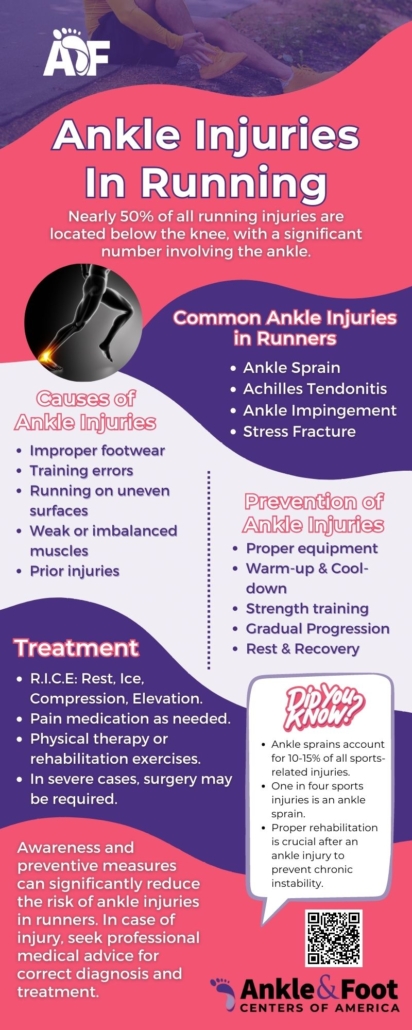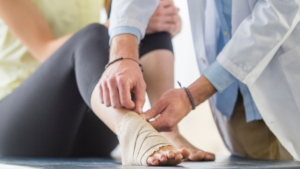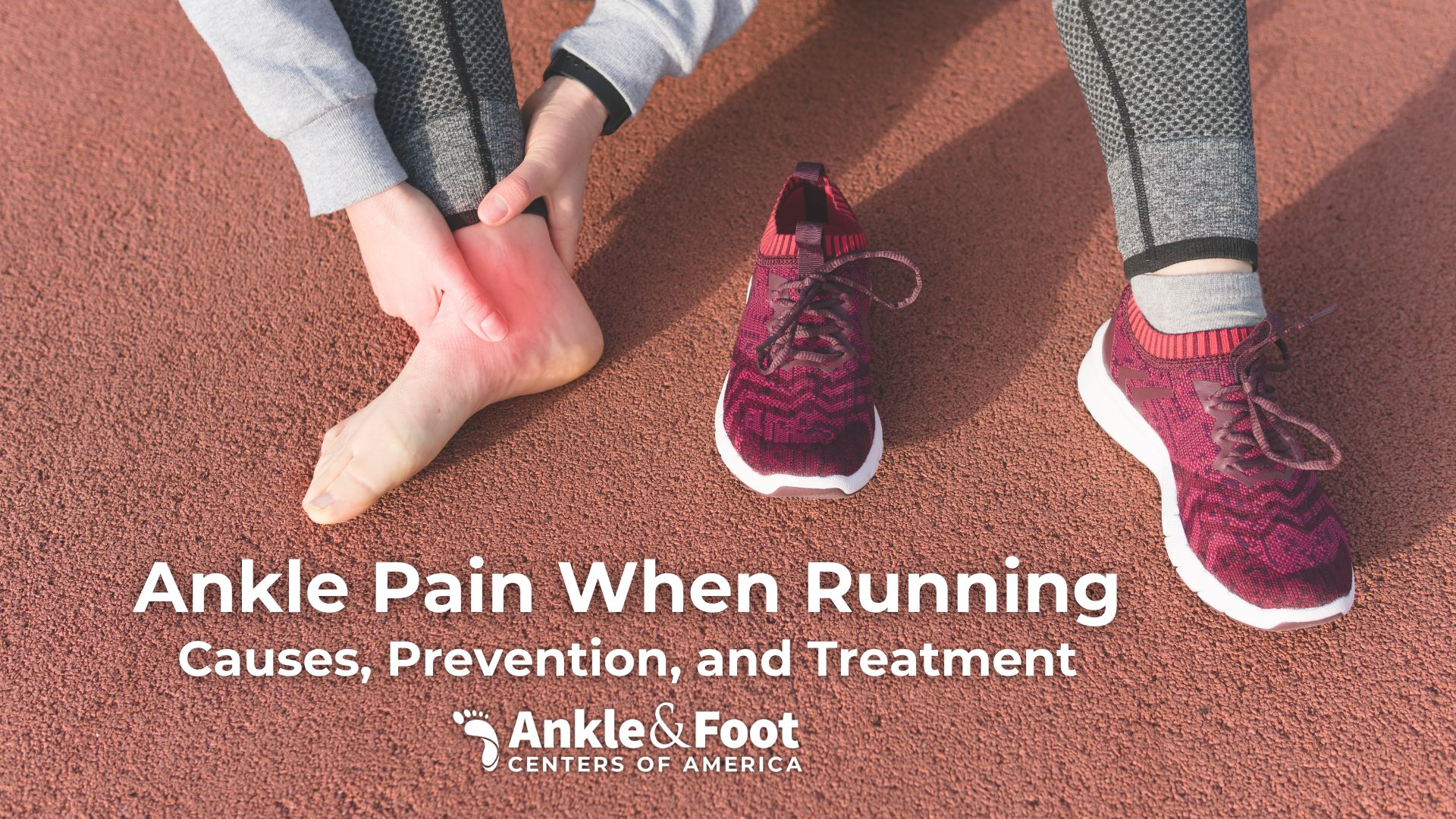Table of Contents
Introduction
Running is a popular form of exercise that offers numerous health benefits, including improved cardiovascular fitness, weight control, and mood enhancement. However, it’s not without its potential drawbacks. One of the most common issues faced by runners of all levels is ankle pain. This discomfort can range from a mild annoyance that fades shortly after a run, to a severe, persistent pain that hinders mobility and may signal a more serious condition.
Understanding ankle pain from running is crucial for every runner. It not only helps in identifying the problem early but also aids in seeking the right treatment and taking preventive measures. This article aims to provide an in-depth understanding of ankle pain associated with running, its causes, prevention strategies, and treatment options. Whether you’re a seasoned marathoner, a casual jogger, or someone considering taking up running, this comprehensive guide will equip you with the knowledge to handle ankle pain effectively.
Understanding Ankle Pain from Running
 Ankle pain from running is a discomfort or pain in the ankle joint or surrounding area that occurs during or after a run. It can be acute, occurring suddenly during a run, or chronic, developing gradually over time. The pain can be localized to one area of the ankle or spread to the foot or lower leg. It may be accompanied by other symptoms such as swelling, bruising, stiffness, or difficulty in walking or bearing weight on the affected foot.
Ankle pain from running is a discomfort or pain in the ankle joint or surrounding area that occurs during or after a run. It can be acute, occurring suddenly during a run, or chronic, developing gradually over time. The pain can be localized to one area of the ankle or spread to the foot or lower leg. It may be accompanied by other symptoms such as swelling, bruising, stiffness, or difficulty in walking or bearing weight on the affected foot.
The ankle joint is a complex structure made up of bones, ligaments, tendons, and muscles. It bears the body’s weight and handles the stress of movement, making it particularly susceptible to injury and pain, especially in activities involving repetitive impact, like running.
Different types of ankle pain experienced by runners can indicate various conditions. These include common issues like sprains and strains, overuse injuries like tendinitis, or more severe conditions like stress fractures. Understanding the nature of your ankle pain is the first step towards addressing the problem and getting back to your running routine.
Causes of Ankle Pain from Running
Running involves repetitive impact on the ankles, which can lead to various injuries and conditions causing pain. Understanding these causes is crucial in preventing and treating ankle pain effectively. Here are some of the most common causes:

Ankle Strain
An ankle strain is an injury to the muscles or tendons in the ankle. Tendons are fibrous tissues that connect muscles to bones. When these tissues are stretched beyond their limit, it can result in a strain. In runners, this can occur due to sudden, explosive movements, such as sprinting or changing direction quickly.
Symptoms of an ankle strain include pain, swelling, muscle spasms, and limited flexibility in the ankle. The pain is usually localized to the area of the strained muscle or tendon and may increase when you use the affected muscle.
Ankle Sprain
An ankle sprain is one of the most common injuries in runners. It occurs when the ligaments, which are the fibrous tissues connecting the bones in the ankle, are stretched or torn. This can happen when the foot is twisted or turned awkwardly, a common mishap during running, especially on uneven surfaces.
Ankle sprains are characterized by pain, swelling, bruising, and difficulty bearing weight on the affected foot. The severity of the sprain can vary from a minor stretch to a complete tear of the ligament.
Tendinitis
Tendinitis is an overuse injury resulting from the inflammation of a tendon. In runners, Achilles tendinitis is particularly common. The Achilles tendon, which connects the calf muscles to the heel bone, can become inflamed due to repetitive stress and overuse, causing pain and stiffness at the back of the ankle.
Symptoms of Achilles tendinitis include pain and swelling in the heel, especially during or after running, stiffness in the ankle in the morning, and thickening of the tendon.
Stress Fracture
A stress fracture is a small crack in a bone that occurs over time due to repetitive force, often from overuse — such as repeatedly jumping up and down or running long distances. In runners, stress fractures often occur in the foot or ankle.
Symptoms of a stress fracture include aching pain in the foot or ankle during exercise, which often lessens during rest, swelling on the top of the foot or the outside of the ankle, tenderness to touch at the site of the fracture, and possible bruising.
Prevention of Ankle Pain from Running
Preventing ankle pain from running is far more desirable than having to treat it. Here are some strategies that can help keep your ankles healthy and pain-free:
Choosing the Right Running Shoes
 One of the most important aspects of preventing ankle pain is wearing the right running shoes. Shoes that fit well and are designed for running can provide the necessary support and cushioning for your feet and ankles. Here are some tips for choosing the right running shoes:
One of the most important aspects of preventing ankle pain is wearing the right running shoes. Shoes that fit well and are designed for running can provide the necessary support and cushioning for your feet and ankles. Here are some tips for choosing the right running shoes:
- Fit: Your running shoes should fit comfortably, with enough room for your toes to move but not so loose that your foot slides around. The heel should be snug and secure.
- Support: Look for shoes that provide good arch support. This can help distribute the impact of running more evenly across your foot and ankle.
- Cushioning: Running shoes should have adequate cushioning to absorb the impact of your foot striking the ground. This can help reduce the strain on your ankles.
- Running Style and Surface: Different types of running require different types of shoes. For example, trail running shoes offer more traction for off-road surfaces, while road running shoes are lighter and more flexible. Your running style, whether you’re a forefoot striker, midfoot striker, or heel striker, also influences the type of shoe that will suit you best.
Proper Running Techniques
Using proper running techniques can significantly reduce the risk of ankle pain. Here are some tips:
- Warm-Up and Cool Down: Always take time to warm up before a run and cool down afterward. This can prepare your muscles and joints for the run and help prevent injuries.
- Gradual Increase: Increase your running distance and intensity gradually. A sudden increase in mileage or intensity can put too much stress on your ankles and lead to pain or injury.
- Listen to Your Body: If you start to feel pain in your ankles while running, stop and rest. Pushing through the pain can lead to more serious injuries.
Regular Exercise and Stretching
Regular exercise and stretching can strengthen the muscles around your ankles, improve flexibility, and help prevent ankle pain. Here are some exercises and stretches that can help:
- Calf Raises: Stand on the edge of a step with your heels hanging off. Slowly raise your heels up and then lower them down below the step. This exercise strengthens the calf muscles, which support the ankles.
- Ankle Circles: Lift your foot off the ground and slowly rotate your foot and ankle in a circular motion. This exercise improves ankle flexibility.
- Resistance Band Exercises: Use a resistance band to strengthen the muscles around your ankle. You can do exercises such as plantar flexion, dorsiflexion, inversion, and eversion.
Treatment for Ankle Pain from Running
If you’re already experiencing ankle pain from running, don’t worry. There are several treatment options available that can help alleviate your pain and get you back on track. Here’s what you can do:
Rest and Recovery
 Rest is crucial when it comes to treating ankle pain from running. Continuing to run on an injured ankle can exacerbate the injury and prolong your recovery time. Here are some tips for proper rest and recovery:
Rest is crucial when it comes to treating ankle pain from running. Continuing to run on an injured ankle can exacerbate the injury and prolong your recovery time. Here are some tips for proper rest and recovery:
- Rest: Take a break from running and allow your ankle to heal. You can engage in low-impact activities like swimming or cycling to maintain your fitness level during this period.
- Ice: Apply ice to the affected area for 15-20 minutes every 2-3 hours for the first 24-72 hours. This can help reduce swelling and pain.
- Compression: Use a compression bandage or ankle support to help reduce swelling and provide support to the injured ankle.
- Elevation: Elevate your ankle above the level of your heart as much as possible to help reduce swelling.
Physical Therapy
Physical therapy can be highly beneficial in treating ankle pain from running. A physical therapist can provide you with a personalized exercise program to improve strength, flexibility, and balance, which can help prevent future injuries. Here’s what you can expect:
- Strengthening Exercises: Your physical therapist will guide you through exercises to strengthen the muscles around your ankle, improving its stability.
- Stretching Exercises: Stretching exercises can help improve flexibility and range of motion, reducing the risk of future ankle sprains.
- Balance and Stability Exercises: These exercises can help improve your balance and stability, reducing the risk of ankle sprains.
Medication and Surgery
 In some cases, medication or surgery may be necessary to treat ankle pain from running. Always consult with a healthcare professional before starting any medication. Here’s what you might expect:
In some cases, medication or surgery may be necessary to treat ankle pain from running. Always consult with a healthcare professional before starting any medication. Here’s what you might expect:
- Medication: Over-the-counter pain relievers and anti-inflammatory drugs can help reduce pain and swelling. In some cases, a doctor may prescribe stronger medication.
- Surgery: In severe cases, such as a complete ligament tear or a stress fracture that doesn’t heal with rest, surgery may be necessary. The type of surgery will depend on the nature and severity of the injury.
Remember, the best treatment for ankle pain from running is prevention. By wearing the right shoes, using proper running techniques, and incorporating regular exercise and stretching into your routine, you can significantly reduce your risk of experiencing ankle pain from running.
Frequently Asked Questions
In this section, we’ll address some of the most frequently asked questions about ankle pain from running. These questions and answers should provide you with a more comprehensive understanding of this common issue among runners.
What causes ankle pain when running?
Ankle pain when running can be caused by a variety of factors, including improper running shoes, poor running technique, overuse, or an underlying injury such as a sprain, strain, tendinitis, or stress fracture.
How can I prevent ankle pain when running?
Preventing ankle pain when running involves wearing the right running shoes, using proper running techniques, and incorporating regular exercise and stretching into your routine. It’s also important to listen to your body and not push through pain.
What are some treatments for ankle pain caused by running?
Treatments for ankle pain caused by running can range from rest and ice to physical therapy and, in severe cases, surgery. The right treatment for you will depend on the cause and severity of your ankle pain.
How long should I rest my ankle after experiencing pain from running?
The length of rest needed after experiencing ankle pain from running will depend on the cause and severity of the pain. Minor injuries may require a few days to a week of rest, while more severe injuries may require several weeks or even months. Always consult with a healthcare professional for personalized advice.
Can running shoes affect ankle pain?
Yes, running shoes can significantly affect ankle pain. Shoes that don’t fit properly or don’t provide enough support can increase the risk of ankle injuries. On the other hand, the right running shoes can provide the necessary support and cushioning to help prevent ankle pain.
How can I strengthen my ankles for running?
Strengthening your ankles for running can involve a variety of exercises, including calf raises, ankle circles, and resistance band exercises. A physical therapist can provide you with a personalized exercise program to strengthen your ankles.
Can I still run with ankle pain?
It’s generally not recommended to run with ankle pain, as this can exacerbate the injury and prolong recovery time. If you’re experiencing ankle pain, it’s best to rest and seek advice from a healthcare professional.
What are some exercises to relieve ankle pain from running?
Exercises to relieve ankle pain from running can include gentle stretching and strengthening exercises, such as calf stretches, ankle circles, and resistance band exercises. A physical therapist can provide you with a personalized exercise program to help relieve your ankle pain.

Conclusion
Ankle pain from running is a common issue that can affect runners of all levels. However, with the right knowledge and strategies, you can effectively manage and prevent this condition.
Understanding the causes of ankle pain, implementing preventive measures, and knowing how to treat the pain when it occurs are all crucial aspects of maintaining your running regimen and overall health.
Remember, the right running shoes, proper running techniques, and regular exercise and stretching can go a long way in preventing ankle pain. However, if you do experience ankle pain, it’s important to rest, seek appropriate treatment, and consult with a healthcare professional if necessary.
Running is a rewarding activity that offers numerous health benefits. Don’t let ankle pain stop you from enjoying your run. With the information and tips provided in this article, you can tackle ankle pain head-on and keep moving forward in your running journey.






